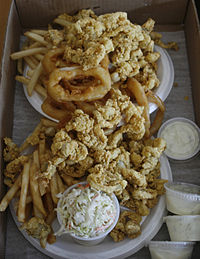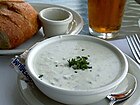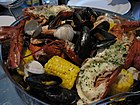바지락튀김
Fried clams 매사추세츠 주 에식스 소재 우드맨스 오브 에식스산 바지락 튀김입니다. | |
| 원산지 | |
|---|---|
| 지역 또는 주 | |
| 작성자 | 로렌스 처비 우드먼 |
| 주요 성분 | 입스위치조개 |
조개튀김은 조개를 우유에 찍어 밀가루를 뿌려 튀긴 것이다.
튀긴 바지락은 "뉴잉글랜드에서 바베큐는 [1]남부에서와 같다"는 상징적인 음식이다.바닷가 조개집(도로변 식당)[1]에서 파는 경향이 있다.클램롤은 핫도그빵에 [2][3]바지락을 튀긴 것입니다.그것들은 보통 타르타르 [2][4]소스와 함께 제공됩니다.
준비
조개는 증발된 우유에 담근 다음 일반, 옥수수,[1][5] 페이스트리 가루로 코팅됩니다.코팅된 바지락은 유채기름, 콩기름 또는 [1][5]기름에 튀겨집니다.
뉴잉글랜드에서 흔히 볼 수 있는 변종은 "전체 배"로 알려진 부드러운 껍데기 전체로 만들어집니다; 이것들은 조개의 위장관을 포함하고 더 풍부한 [1][6]맛을 가지고 있습니다.조개의 [5]목이라고 불리는 쫄깃쫄깃한 사이펀을 제거하는 식당도 있다.
뉴잉글랜드 밖에서는 대서양 바다 조개를 얇게 썰어서 만든 조개 조각이 더 [7]흔하다.
역사
튀긴 바지락은 [8]1840년부터 언급되어 파커 하우스 호텔의 1865년 메뉴에 올라 있다.1865년 메뉴는 튀김과 튀김을 모두 제공하지만 [9]조개 튀김만 제공한다.
19세기 미국 요리책에는 조개 튀김의 여러 가지 다른 요리가 묘사되어 있습니다.
- 조개 버터 소테(1850)[10]
- (계란 결합이 있는) 조개를 빵으로 만들어 버터 또는 지방으로 소테한다(1850)([10]1904)[11]
- '클램 프리터'라고 불리는 버터에 튀긴 달걀 반죽에 담긴 바지락. (1850년)[10] ([11]1904
현대판 튀김은 일반적으로 메사추세츠 에식스 출신의 로렌스 "처비" 우드만이 만든 것으로 알려져 있다.그는 1916년 [12]7월 3일 현재 에식스의 우드만스라는 작은 길가 레스토랑에서 첫 회를 만들었다고 한다.그의 특기 중 하나는 감자칩이었고, 그래서 그는 튀김을 위한 큰 통을 가지고 있었다.그는 집에서 [13]가까운 에식스 강의 갯벌에서 직접 채취한 조개를 사용했다.
이후 매사추세츠 입스위치에 본사를 둔 소프론 브라더스 클램사의 토마스 소프론은 단단한 껍질의 바다 조개의 "발"로 만든 조개 스트립을 만들었다.그는 이것들을 하워드 존슨스에 독점 거래로 팔았고, 체인점이 확장되면서 [14][15]전국적으로 인기를 끌었다.
건강 및 식사에 관한 고려사항
조개 자체의 콜레스테롤과 지방 함량은 낮지만 조개 튀김은 조리용 [16]지방을 흡수한다.
레퍼런스
- ^ a b c d e Leite, David (2007-08-29). "In a '64 T-Bird, Chasing a Date With a Clam". New York Times. Retrieved 2007-08-21.
Fried clams are to New England what barbecue is to the South. Like barbecue, the best clams come from small roadside shacks run in pragmatic mom-and-pop style.
- ^ a b "Sandwich Pride". U.S. Department of State. Archived from the original on 2007-12-21. Retrieved 2007-12-19.
For the fried clam roll, sweet, full-bellied clams are dipped in batter and thrown into the deep fryer. A few minutes later they're laid into a top-loaded hot dog bun with some tartar sauce and a slice of lemon on the side.
- ^ "An Ode to the Clam". National Public Radio.
During the consumption of that clam roll and the one that followed it ... Daniel Pinkwater longs for a great clam roll from his home in New ...
- ^ "Battered and Fried". Battered and Fried. Archived from the original on 2007-12-07. Retrieved 2007-12-19.
Fried Clam Strip Basket. Lightly Breaded Clam strips Deep Fried & served with tartar sauce.
- ^ a b c Parrish, Marlene (October 21, 2007). "A mission to find glorious fried clams". Pittsburgh Post-Gazette. Retrieved 2007-12-19.
The clams are dug, shelled every morning and the siphons (or "necks") are cut off. (That's the part that can sometimes be as chewy as a rubber band.) Then they are soaked in evaporated milk, dredged in just a bit of corn and white flours and fried in lard.
- ^ Moskin, Julia (2005-06-13). "Dark Days for the Fried Clam, a Summer Staple". New York Times. Retrieved 2007-12-19.
In the raw, a clam consists of a longish muscular foot used for digging; inside the shell is a mass of siphons, stomach and gills, referred to as the belly, which is surrounded by a band of muscle, known as the neck. The best fried clams include both belly and neck, and can be popped into the mouth in one bite.
- ^ "The great clam debate". Cape Cod Times. Retrieved 2007-12-19.
Fried clams with bellies or without? The age-old question of how to eat these deep-fried bits of summertime goodness may never be answered, but as local clam connoisseurs will tell you, those with guts enough to eat them whole get the benefit of the full flavor. The line between those who do and those who don't seems clearly drawn in geographical terms. Real Cape Codders either eat the bellies or are too ashamed to admit they don't. Clam strips, made popular by the ...
- ^ 윌리엄 E. 버튼, 윌리엄 E의 '투마투르기아'버튼과 에드거 A. Poe, eds, Button's Gentleman's Magazine, Monthly American Review, 1840년 1월, 페이지 70
- ^ a b c Mary Bouvier Peterson, Martha Read, The National Cookbook, 1856 (1850년 서문), 33페이지
- ^ a b Charles Fellows, The Cournary Handbook, 시카고, 1904, 페이지 58
- ^ Jenkins, Nancy (August 21, 2002). "The Deep-Fried Truth About Ipswich Clams". The New York Times. Archived from the original on April 17, 2009. Retrieved 2009-03-24.
- ^ Roberts, Steven V. (1983-06-05). "Fare of the Country; Yankee Staple: Clam Fry". New York Times. Retrieved 2007-09-21.
According to Doug Woodman, Chubby's grandson, someone suggested that frying clams might be a good idea.
- ^ "Thomas Soffron, 96, Creator of Clam Strips". New York Times. 2004-02-28. Retrieved 2007-10-23.
Thomas Soffron, a clam digger and entrepreneur who created clam strips, which brought low-priced fried clams to restaurants nationwide, died here last Saturday, The Boston Globe reported. He was 96.
- ^ Sovich, Nina (2004-05-01). "Clam King". CNN. Retrieved 2007-12-15.
Like many famous Greeks, and not a few New Englanders, Thomas Soffron found his fortune at sea. An immigrant from Calamata, Greece, Soffron invented clam strips: battered and fried slices from the "foot" of hard-shelled sea clams (which held up better when frozen than did the coastal variety). For years Soffron Brothers Clam Co., based in Ipswich, Massachusetts, served as the exclusive supplier of clam strips to the Howard Johnson's restaurant chain, which sold the whole country on this Down East delicacy. Few HoJo's are left, but the clam strip's enduring popularity stands as its creator's legacy. Soffron died on February 21 at age 96 in Ipswich, his hometown.
- ^ Roberts, Steven V. "Shellfish and Fat and Cholesterol". Dr. Gourmet Website. p. 1. Retrieved 2009-05-27.
Fried clams are a problem, not because of the clams but because of the cooking method.






